
Caterpillars are the larval stage of members of the order Lepidoptera.

Lepidoptera or lepidopterans is an order of winged insects that includes butterflies and moths. About 180,000 species of the Lepidoptera have been described, representing 10% of the total described species of living organisms, making it the second largest insect order with 126 families and 46 superfamilies, and one of the most widespread and widely recognizable insect orders in the world.

Moths are a group of insects that includes all members of the order Lepidoptera that are not butterflies. They were previously classified as suborder Heterocera, but the group is paraphyletic with respect to butterflies and neither subordinate taxon is used in modern classifications. Moths make up the vast majority of the order. There are approximately 160,000 species of moth, many of which have yet to be described. Most species of moth are nocturnal, although there are also crepuscular and diurnal species.

The Tortricidae are a family of moths, commonly known as tortrix moths or leafroller moths, in the order Lepidoptera. This large family has over 11,000 species described, and is the sole member of the superfamily Tortricoidea, although the genus Heliocosma is sometimes placed within this superfamily. Many of these are economically important pests. Olethreutidae is a junior synonym. The typical resting posture is with the wings folded back, producing a rather rounded profile.

The genus Anchusa belongs to the borage family (Boraginaceae). It includes about 35 species found growing in Europe, North Africa, South Africa and Western Asia. They are introduced in the United States.

Manduca quinquemaculata, the five-spotted hawkmoth, is a brown and gray hawk moth of the family Sphingidae. The caterpillar, often referred to as the tomato hornworm, can be a major pest in gardens; they get their name from a dark projection on their posterior end and their use of tomatoes as host plants. Tomato hornworms are closely related to the tobacco hornworm Manduca sexta. This confusion arises because caterpillars of both species have similar morphologies and feed on the foliage of various plants from the family Solanaceae, so either species can be found on tobacco or tomato leaves. Because of this, the plant on which the caterpillar is found does not indicate its species.
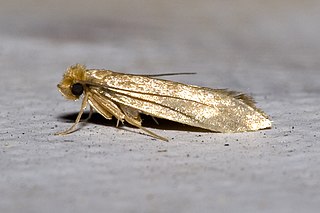
Tineola bisselliella, known as the common clothes moth, webbing clothes moth, or simply clothing moth, is a species of fungus moth. It is the type species of its genus Tineola and was first described by the Swedish entomologist Arvid David Hummel in 1823. It and a number of closely-related species are together known as the clothes moths due to their function as pests in human households. The specific name is commonly misspelled biselliella – for example by G. A. W. Herrich-Schäffer, when he established Tineola in 1853.
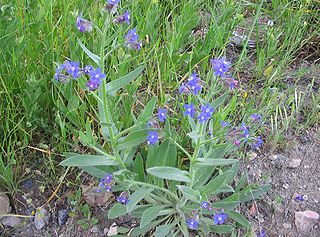
Anchusa azurea is a species of flowering plant in the family Boraginaceae, known by the common names garden anchusa and Italian bugloss. This bristly herbaceous perennial may reach 1.5 m (4.9 ft) tall and 60 cm (24 in) wide. It has straight lance-shaped leaves and petite tubular flowers about 15 millimeters across with five bright violet-blue petals. These flowers, which typically appear in May–July, are edible and attract bees. This species is native to Europe, western Asia, and eastern Maghreb.

Utetheisa pulchella, the crimson-speckled flunkey, crimson-speckled footman, or crimson-speckled moth, is a moth of the family Erebidae. The species was first described by Carl Linnaeus in his 1758 10th edition of Systema Naturae.

Abantiades latipennis, known as the Pindi moth, is a species of moth in the family Hepialidae. It may also be referred to as a swift moth or a ghost moth, as this is a common name associated with Hepialidae. Endemic to Australia and identified in 1932, it is most populous in temperate rainforest where eucalypti are prevalent, as the larvae feed primarily on the roots of these trees. Females lay eggs during flight in a scattering fashion. The larvae live for over eighteen months underground, while adult moths survive for approximately one week, as they have no mouthparts with which to feed. The moths are preyed upon by a number of predators, including bats and owls. Brown in colour overall, males are paler and the identifying silver bars of the male's wings are more prominent than those of the female's, with dark margins. Male adults are generally smaller.

Euchalcia consona is a moth of the family Noctuidae. It is found in Europe from Austria, through Hungary and Siberia up to the Ural mountains.
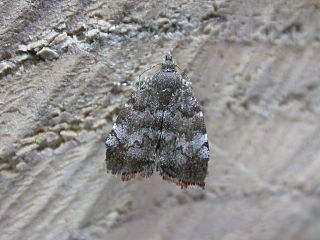
Choreutis pariana, the apple-and-thorn skeletonizer or apple leaf skeletonizer, is a moth of the family Choreutidae. The moth was first described by the Swedish entomologist Carl Alexander Clerck in 1759. It is native to Eurasia and was introduced to New England, USA in 1917. It was recenly also stated in Korea.

Coleophora pennella is a moth of the family Coleophoridae. It is found in most of Europe.
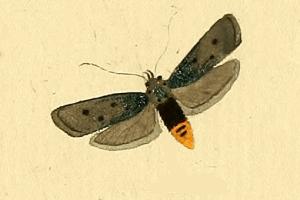
Ethmia aurifluella is a moth in the family Depressariidae. It is found in Morocco, Asia Minor, Syria, Iran, the Iberian Peninsula, France, Switzerland, Austria, Italy, Albania, North Macedonia, Bulgaria, Greece, Turkey, Romania, Ukraine and southern Russia.
Ethmia lepidella is a moth in the family Depressariidae. It is found in Algeria, Tunisia, Libya, the Palestinian Territories, the United Arab Emirates, Turkey and Spain.
Cynaeda gigantea is a species of moth in the family Crambidae. It is found in France, Switzerland, Croatia, Bosnia and Herzegovina, Hungary, Romania, the Republic of Macedonia, Greece and Turkey.
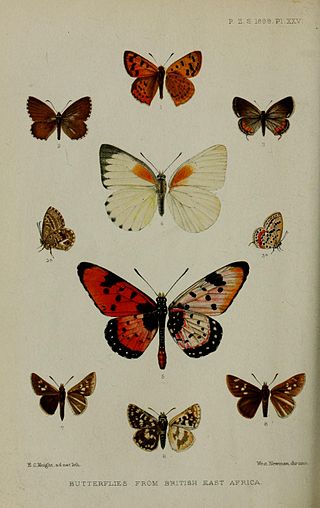
Euchrysops crawshayi, Crawshay's blue, is a butterfly in the family Lycaenidae. It is found in Kenya, Uganda, Tanzania, Burundi, Rwanda, Sudan and the Democratic Republic of the Congo. The habitat consists of moist savanna.

Alsophila aceraria is a species of moth in the family Geometridae. It is found from south-western Europe and France to Germany, Austria, Italy, western Ukraine, the Balkan Peninsula, the southern Crimea, the Caucasus and Transcaucasus.

Lymantria dispar dispar, commonly known as the gypsy moth, European gypsy moth, LDD moth, or North American gypsy moth or spongy moth, is a species of moth in the family Erebidae. It has a native range that extends over Europe and parts of Africa, and is an invasive species in North America.

Tinagma anchusella is a moth in the Douglasiidae family. It is found in Denmark, Germany, Austria, Poland, Bulgaria, Greece, Estonia, Latvia, Sweden, Ukraine and on Cyprus. It is also found in Turkey, Jordan and the Caucasus region.


















